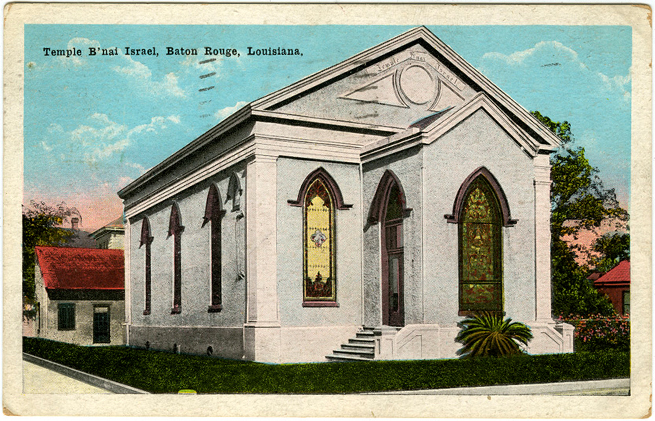2.3 Baton Rouge, Louisiana
B’nai Israel, 218 5th Street, SE corner of 5th and Laurel streets
Architect and date unknown; former Christian school acquired in 1876 and dedicated in 1877
E. C. Kropp Co., Milwaukee, Wisconsin, publisher; no publication date, but postmarked September 27, 1921
This view shows the modest B’nai Israel (Sons of Israel) synagogue of Baton Rouge, built as a Catholic Brothers’ school but transformed into a synagogue when the small Baton Rouge congregation traded properties in 1876.
In the United States in the latter part of the 19th century, it was often the women of a congregation who were most determined to ensure its success and survival. In 1871, Congregation Shaare Chesed (Gates of Loving Kindness) worshiped at Dalsheimer Hall, a community gathering place for speeches, meetings, and dances. The ladies of the congregation, however, were eager to build a permanent synagogue. Thus, in January 1871, they organized the Ladies’ Hebrew Aid Association “for the purpose of building in the City of Baton Rouge a synagogue for Jewish Worship, and we have adopted the following constitution for our government.” They raised $1,399.35 to purchase Torah covers, carpets, chandeliers, draperies, an organ, and an Eternal Light.
Despite the happy beginning, it took many years for the congregation to settle in. The swap of buildings had not given Shaare Chesed legal title; lawsuits ensued, and after going so far as to decorate the synagogue, the congregation was evicted. The situation deteriorated and its members voted to disband in 1882, but by 1886, they were able to purchase the building and move back. At that time, the congregation changed its name to B’nai Israel. Its charter stated the purposes of the corporation: “the cherishing, preserving and perpetuating the principles of pure Judaism, as well as for the cultivation and spread of enlightened religious sentiment.”
The postcard pictured here, undated but postmarked in 1921, shows a modest, trim, plastered building, probably wood frame underneath, with combined Gothic and classical architectural elements. We don’t know what the building looked like originally or whether it was modified through the years. It is tempting to think that the Catholic school was built in the Gothic style sometime in the mid-19th century and that B’nai Israel renovated the building later in the classical style. The ark, for example, which would have been added by B’nai Israel, was built along classical lines: thin applied pilasters supporting a straight entablature, beneath the half-circle stained glass window. Tall Gothic windows flanked the ark, and in an old photo we can discern that they have a stylized vegetal design without apparent symbols or text—matching the window seen in the postcard on the facade of the entrance projection.
While these and the other Gothic windows look church-like, it should be noted that many contemporary synagogues had similar features. Some, like the Gothic synagogue of Savannah built about the time the Baton Rouge building was first occupied for Jewish worship, do resemble churches. Much closer to Baton Rouge, however, was the first synagogue in Alexandria, Louisiana, built in 1871, with windows crowned with pointed arches. While we know the Baton Rouge windows were made of stained glass, we don’t know much more.
From the postcard view, it appears the front and side windows included roundels with symbols. After the building was sold in the 1950s, the windows were removed and stored, but most were stolen and only one remains. This was a half-round window, probably set high in the ark wall that included the Hebrew inscription “Know before whom thou stands.” This window has been restored and is on view in the new temple designed by architects Bodman, Murrill, and Smith, which the congregation occupied in 1954.
